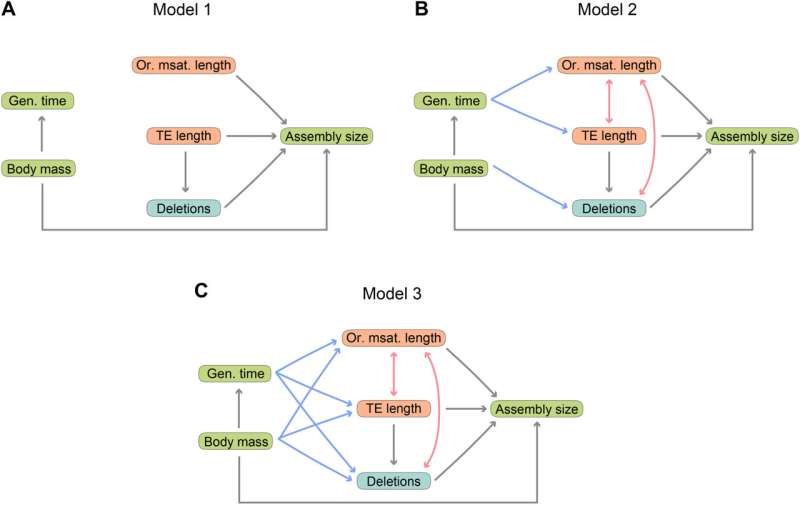Models that are tested by PSEMs. The models describe how avian genomic attributes, including orthologous microsatellite length, TE length, and deletion length, evolved under the covariation of DNA loss and gain (the arrow between TE length and deletion length), effect of life history traits on genomic attributes (arrows between body mass, generation time, and genomic attributes), and contributions of genomic attributes to genome size (or assembly size). Gray arrows indicate relationships that are common across all three models. Blue/red arrows refer to model-specific relationships. Single-directional arrows indicate relationships that are presumably causational, and bidirectional arrows indicate correlated errors among variables. (A) Model 1: The evolution of genomic attributes is not related to life history traits. (B) Model 2: Life history traits correlate with the evolution of genomic attributes as predicted by a priori hypothesis. (C) Model 3: A full model that makes every possible connection between life history traits and genomic attributes. Credit: Science Advances (2022). DOI: 10.1126/sciadv.abo0099
Mutations are the raw material of evolution. For example, a single change in an DNA base pair can cause a protein molecule to lose its function, with potentially major effects on the overall organism. However, mutations—and especially the ones that do not have major effects—can also provide a roadmap to determining if there is a pattern in the evolution of genomic attributes such as nucleotide substitutions.
In a recent study published in Science Advances, Prof. Lei Fumin from the Institute of Zoology of the Chinese Academy of Sciences, together with researchers from Chicago's Field Museum and Zhejiang University, revealed that genomic attributes are correlated with life history traits in Neoaves, the avian clade that makes up over 95% of all extant bird species.
As early as 1993, Martin and Palumbi found that smaller animals, both endotherms and ectotherms, harbor more changes in the DNA sequences of certain genes than do larger animals. Based on these findings, scientists suspected that life history traits such as metabolic rate and generation time, both of which are closely scaled with body mass, may affect the rate at which mutations are produced and thus accumulated.
In other words, since metabolic rate (or body mass) and generation time may reflect different aspects of mutation generation, we may expect that the accrual of mutations that are generated differently are related to different life history traits.
With advances in genome sequencing technology and rich long-term data accumulated about the life history traits of birds, scientists are now able to tackle this issue from a slightly different genomic perspective. For example, instead of studying changes in base pairs of DNA sequences, the current researchers looked at a suite of genomic attributes that may represent mutations generated by different processes.
In this study, using more than 200 whole-genome sequences that the Bird 10,000 Genomes Project produced over the past decade, the researchers investigated the length of orthologous microsatellites, transposable elements, and DNA deletions. They specifically studied how these genomic traits correlate with generation time and body mass. Since transposable elements and DNA deletions also drive the expansion and contraction of genome size, the researchers also studied the relationship between these two genomic traits and variation in genome size.
Using statistical models, the researchers found support for a connection between generation time and the length of orthologous microsatellites and transposable elements among neoavian birds (excluding passerines). They also found support for a connection between body mass and the length of DNA deletions among the same birds.
In passerines, on the other hand, the pattern is less significant. Nevertheless, a connection between generation time and the length of DNA deletions is supported.
The contribution of DNA deletions to genome size evolution is similar to that of transposable elements, according to Prof. Lei.
This study highlights the connection between life history traits and genomic attributes. In particular, it shows that smaller birds accumulate more DNA deletions and have smaller genomes.
More information: Yanzhu Ji et al, Orthologous microsatellites, transposable elements, and DNA deletions correlate with generation time and body mass in neoavian birds, Science Advances (2022). DOI: 10.1126/sciadv.abo0099
Journal information: Science Advances
Provided by Chinese Academy of Sciences
























